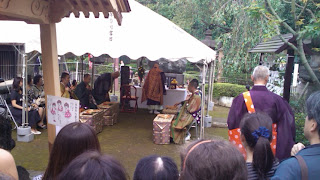I analysed a part of a book called “Tamadasuki ” (『玉襷』1832) by nativist scholar Hirata Atsutane (平田篤胤; 1776-1843). In the part I found, Hirata talks about the function of the kamidana, as well the proper rituals at the time.
He starts of by saying that a kamidana is a kind of himorogi 神籬 (basically a primitive sanctuary, but the exact meaning of the word seems to have changed over time) in which the eight thousand gods dwell. As it is an alternative to going to an actual shrine, it should be treated with respect. Since it is placed on the inside of the house it is prone to be tainted by impurity (けがれ kegare) if the residents of the house are, for one reason or another, impure.
After this, Hirata gives an example. When one of his parents passes away he mourns for 50 days and in the case of one of his grandparents 30 days. During this period one should refrain/he refrains from performing the rituals or prayers towards the gods. When the mourning period has ended the rituals are resumed after a ritual cleansing (身滌祓 misogiharai). Hirata probably means that the performing of rituals by an impure person (because of the loss of a family member) will cause the impurity to spread to the kamidana.
He says that it is also possible to ask a distant relative (someone who is not officially in the mourning period) to take over the rituals during this time, but one must let him execute Bekka Kessai 別火潔斎 (I will have to look into the exact meaning of this word, but at this point it appears to me that it is a kind of abstinence that involves him using a different [sacred?] fire to cook his meal than the people who are tainted because of the mourning).
This description by Hirata is likely to seem very strict to modern people, but it gives an interesting insight into rituals observed by at least a number of people in the first half of the 19th century. We must note, however, that Hirata is a nativist scholar (a so-called kokugakusha国学者 ) and that his work shows an explicit preference for Shintoism and an equally explicit disregard for Buddhism. It is therefore not completely clear that the rituals he speaks of are descriptive or simply prescriptive. There may have been a lot of his contemporaries who either had no kamidana at all in their homes or executed rituals that were more adapted to their personal or local customs. Furthermore, it is thinkable that certain practises that are said to be typical of Buddhist rituals (the burning of incense, the use of singing bowls etc.) were used to venerate the kami as well by the commoners, on purpose or perhaps out of sheer ignorance.
Sources:
- Rinsen-shoten (臨川書店).『神道大辭典』(Shintō dai-jiten). Tokyo: Heibonsha edition (平凡社版), 1969.
- Shields, James Mark. Critical Buddhism: engaging with modern Japanese Buddhist thought. Farnham: Ashgate Publishing, Ltd., 2011.









